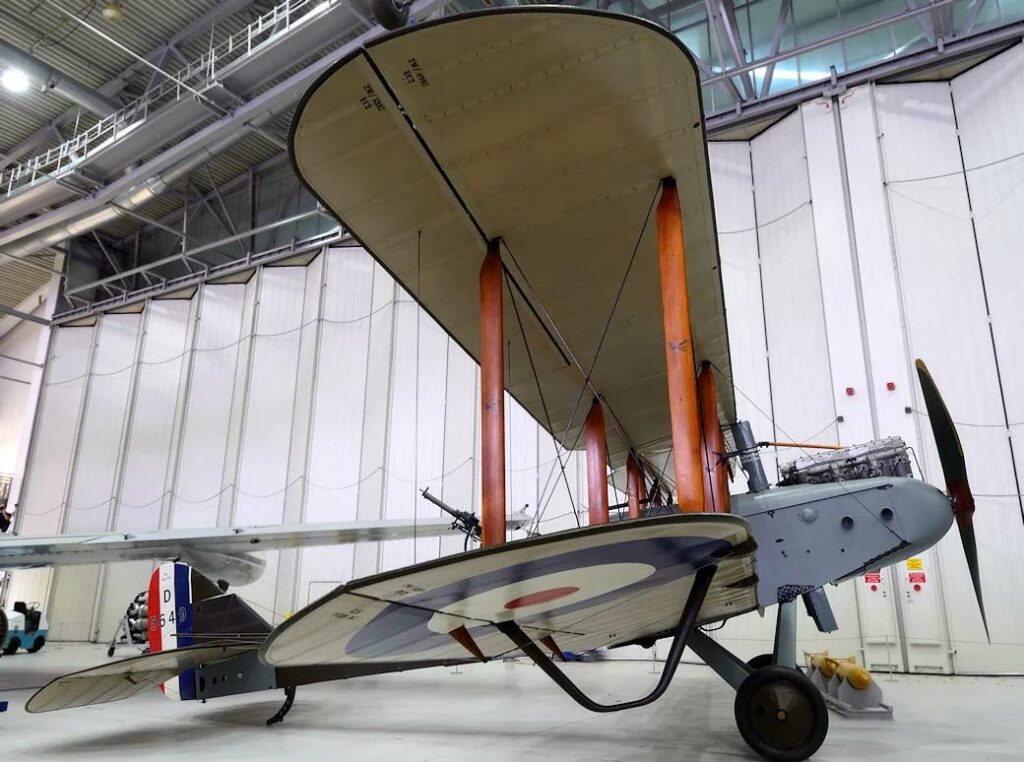WWI British bomber, Airco DH.9: Biplane design, unreliable BHP engine, notable for widespread use despite performance issues. This article presents an in-depth view of the Airco DH.9, a World War I British bomber known for its service despite its performance limitations. The aircraft’s development history, design details, performance metrics, military use, and combat role are examined against the backdrop of the WWI aviation landscape.
The Airco DH.9 was a British bomber aircraft that played a significant role during World War I, despite technical shortcomings that hampered its effectiveness. This biplane was a development of the successful Airco DH.4, designed to improve endurance and payload capacity for longer-range bombing missions.
History of the Development of the Airco DH.9
In the midst of World War I, the Airco DH.9 was conceived to meet the Royal Flying Corps’ (RFC) growing need for a robust, long-range bomber capable of reaching deeper into enemy territory. The epoch was characterized by rapid advancements in aviation technology, driven by the exigencies of war.
The DH.9 was developed by the Aircraft Manufacturing Company Limited (Airco), under the direction of chief designer Geoffrey de Havilland. The aim was to produce a bomber with greater range and payload than the preceding DH.4, while utilizing the same production facilities and much of the existing design to expedite deployment.
Launched in the latter part of 1916, the design phase moved quickly, and the first DH.9 took to the skies on 9th December 1916. It was a period of optimistic expansion of the bomber’s role in warfare, where strategic bombing was seen as a potential war-winning strategy.
Design of the Airco DH.9
The Airco DH.9 was a conventional biplane design with a wingspan of 42 feet 4½ inches (12.92 meters). Its structure comprised a wooden frame covered with plywood and fabric, which was typical of the period. The aircraft’s dimensions allowed for a payload that was considerable for its day, though the design was compromised by the engine chosen.
One of the major drawbacks was the initial powerplant, the Siddeley-Deasy Puma, an unreliable 230 horsepower engine that was supposed to provide better performance than the DH.4’s engine but fell short in practice. The underpowered engine led to poor altitude performance and made the DH.9 vulnerable to enemy fighters and ground fire.
Nonetheless, the design featured some improvements over the DH.4, including better visibility for the crew and a more internalized bomb bay that reduced drag. It had a crew of two, with the pilot seated in front and the observer/gunner positioned behind, manning a .303 in (7.7 mm) Lewis gun on a Scarff ring mount for defense.

Performance of the Airco DH.9
Powered by the 230 hp (172 kW) Siddeley-Deasy Puma engine, the DH.9 had a modest top speed of 98 mph (158 km/h). The service ceiling was approximately 15,500 feet (4,725 meters), and it could reach a range of about 4.5 hours’ flying time at cruising speed, translating to roughly 460 miles (740 kilometers).
When compared to contemporaries such as the more reliable and higher-performing DH.4, the DH.9’s performance was considered a step backward. For example, the DH.4 boasted a top speed of 143 mph (230 km/h) and a service ceiling of 22,000 feet (6,706 meters), significantly outclassing the DH.9 in both respects.
Military Use and Combat of the Airco DH.9
The DH.9 was armed with a forward-firing Vickers machine gun for the pilot and a Lewis gun for the observer. It could carry a bomb load of up to 460 pounds (209 kilograms), allowing for substantial offensive operations.
The DH.9 entered service with the RFC and later the Royal Air Force (RAF) in 1917. It was used extensively on the Western Front, in the Middle East, and on the Macedonian front. Unfortunately, due to its underpowered engine and vulnerability, it suffered heavy losses. The DH.9 was often outclassed by German fighters such as the Albatros D.III and the Fokker Dr.I.
Despite its deficiencies, the DH.9 was widely used, and several were sold or given to other countries post-war, including the United States, Canada, Australia, and several countries in South America. The aircraft was eventually replaced by the DH.9A, which rectified the power issue with a more robust American Liberty engine.
By the end of its service life, the DH.9 had been largely superseded by more capable designs, and its military use was effectively over by the early 1920s.
The Airco DH.9’s story is one of necessity, compromise, and the harsh realities of wartime innovation. While it fell short of expectations, particularly in performance, its widespread use underscored the critical role of strategic bombing in World War I. The DH.9’s operational challenges highlight the pace and perils of aircraft development during the conflict, reflecting both the ingenuity and the haste of the era’s aviation pioneers.
Back to the Warbirds section.